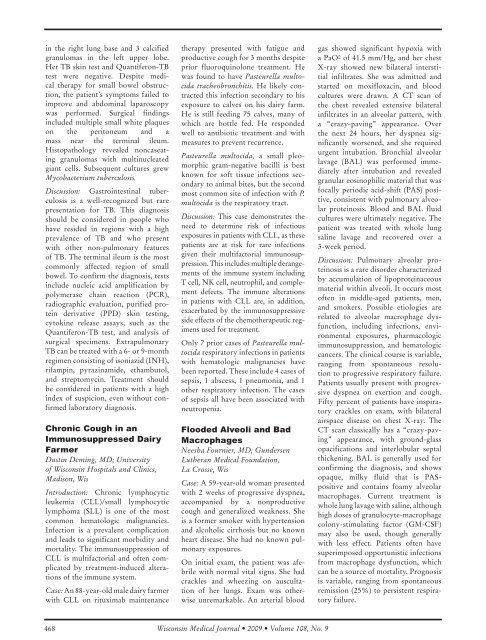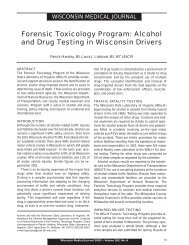WMJ 108no9 - Wisconsin Medical Society
WMJ 108no9 - Wisconsin Medical Society
WMJ 108no9 - Wisconsin Medical Society
You also want an ePaper? Increase the reach of your titles
YUMPU automatically turns print PDFs into web optimized ePapers that Google loves.
in the right lung base and 3 calcified<br />
granulomas in the left upper lobe.<br />
Her TB skin test and Quantiferon-TB<br />
test were negative. Despite medical<br />
therapy for small bowel obstruction,<br />
the patient’s symptoms failed to<br />
improve and abdominal laparoscopy<br />
was performed. Surgical findings<br />
included multiple small white plaques<br />
on the peritoneum and a<br />
mass near the terminal ileum.<br />
Histopathology revealed noncaseating<br />
granulomas with multinucleated<br />
giant cells. Subsequent cultures grew<br />
Mycobacterium tuberculosis.<br />
Discussion: Gastrointestinal tuberculosis<br />
is a well-recognized but rare<br />
presentation for TB. This diagnosis<br />
should be considered in people who<br />
have resided in regions with a high<br />
prevalence of TB and who present<br />
with other non-pulmonary features<br />
of TB. The terminal ileum is the most<br />
commonly affected region of small<br />
bowel. To confirm the diagnosis, tests<br />
include nucleic acid amplification by<br />
polymerase chain reaction (PCR),<br />
radiographic evaluation, purified protein<br />
derivative (PPD) skin testing,<br />
cytokine release assays, such as the<br />
Quantiferon-TB test, and analysis of<br />
surgical specimens. Extrapulmonary<br />
TB can be treated with a 6- or 9-month<br />
regimen consisting of isoniazid (INH),<br />
rifampin, pyrazinamide, ethambutol,<br />
and streptomycin. Treatment should<br />
be considered in patients with a high<br />
index of suspicion, even without confirmed<br />
laboratory diagnosis.<br />
Chronic Cough in an<br />
immunosuppressed Dairy<br />
Farmer<br />
Dustin Deming, MD; University<br />
of <strong>Wisconsin</strong> Hospitals and Clinics,<br />
Madison, Wis<br />
Introduction: Chronic lymphocytic<br />
leukemia (CLL)/small lymphocytic<br />
lymphoma (SLL) is one of the most<br />
common hematologic malignancies.<br />
Infection is a prevalent complication<br />
and leads to significant morbidity and<br />
mortality. The immunosuppression of<br />
CLL is multifactorial and often complicated<br />
by treatment-induced alterations<br />
of the immune system.<br />
Case: An 88-year-old male dairy farmer<br />
with CLL on rituximab maintenance<br />
468<br />
therapy presented with fatigue and<br />
productive cough for 3 months despite<br />
prior fluoroquinolone treatment. He<br />
was found to have Pasteurella multocida<br />
tracheobronchitis. He likely contracted<br />
this infection secondary to his<br />
exposure to calves on his dairy farm.<br />
He is still feeding 75 calves, many of<br />
which are bottle fed. He responded<br />
well to antibiotic treatment and with<br />
measures to prevent recurrence.<br />
Pasteurella multocida, a small pleomorphic<br />
gram-negative bacilli is best<br />
known for soft tissue infections secondary<br />
to animal bites, but the second<br />
most common site of infection with P.<br />
multocida is the respiratory tract.<br />
Discussion: This case demonstrates the<br />
need to determine risk of infectious<br />
exposures in patients with CLL, as these<br />
patients are at risk for rare infections<br />
given their multifactorial immunosuppression.<br />
This includes multiple derangements<br />
of the immune system including<br />
T cell, NK cell, neutrophil, and complement<br />
defects. The immune alterations<br />
in patients with CLL are, in addition,<br />
exacerbated by the immunosuppressive<br />
side effects of the chemotherapeutic regimens<br />
used for treatment.<br />
Only 7 prior cases of Pasteurella multocida<br />
respiratory infections in patients<br />
with hematologic malignancies have<br />
been reported. These include 4 cases of<br />
sepsis, 1 abscess, 1 pneumonia, and 1<br />
other respiratory infection. The cases<br />
of sepsis all have been associated with<br />
neutropenia.<br />
Flooded alveoli and bad<br />
Macrophages<br />
Neesha Fournier, MD; Gundersen<br />
Lutheran <strong>Medical</strong> Foundation,<br />
La Crosse, Wis<br />
Case: A 59-year-old woman presented<br />
with 2 weeks of progressive dyspnea,<br />
accompanied by a nonproductive<br />
cough and generalized weakness. She<br />
is a former smoker with hypertension<br />
and alcoholic cirrhosis but no known<br />
heart disease. She had no known pulmonary<br />
exposures.<br />
On initial exam, the patient was afebrile<br />
with normal vital signs. She had<br />
crackles and wheezing on auscultation<br />
of her lungs. Exam was otherwise<br />
unremarkable. An arterial blood<br />
<strong>Wisconsin</strong> <strong>Medical</strong> Journal • 2009 • Volume 108, No. 9<br />
gas showed significant hypoxia with<br />
a PaO2 of 41.5 mm/Hg, and her chest<br />
X-ray showed new bilateral interstitial<br />
infiltrates. She was admitted and<br />
started on moxifloxacin, and blood<br />
cultures were drawn. A CT scan of<br />
the chest revealed extensive bilateral<br />
infiltrates in an alveolar pattern, with<br />
a “crazy-paving” appearance. Over<br />
the next 24 hours, her dyspnea significantly<br />
worsened, and she required<br />
urgent intubation. Bronchial alveolar<br />
lavage (BAL) was performed immediately<br />
after intubation and revealed<br />
granular eosinophilic material that was<br />
focally periodic acid-shift (PAS) positive,<br />
consistent with pulmonary alveolar<br />
proteinosis. Blood and BAL fluid<br />
cultures were ultimately negative. The<br />
patient was treated with whole lung<br />
saline lavage and recovered over a<br />
3-week period.<br />
Discussion: Pulmonary alveolar proteinosis<br />
is a rare disorder characterized<br />
by accumulation of lipoproteinaceous<br />
material within alveoli. It occurs most<br />
often in middle-aged patients, men,<br />
and smokers. Possible etiologies are<br />
related to alveolar macrophage dysfunction,<br />
including infections, environmental<br />
exposures, pharmacologic<br />
immunosuppression, and hematologic<br />
cancers. The clinical course is variable,<br />
ranging from spontaneous resolution<br />
to progressive respiratory failure.<br />
Patients usually present with progressive<br />
dyspnea on exertion and cough.<br />
Fifty percent of patients have inspiratory<br />
crackles on exam, with bilateral<br />
airspace disease on chest X-ray. The<br />
CT scan classically has a “crazy-paving”<br />
appearance, with ground-glass<br />
opacifications and interlobular septal<br />
thickening. BAL is generally used for<br />
confirming the diagnosis, and shows<br />
opaque, milky fluid that is PASpositive<br />
and contains foamy alveolar<br />
macrophages. Current treatment is<br />
whole lung lavage with saline, although<br />
high doses of granulocyte-macrophage<br />
colony-stimulating factor (GM-CSF)<br />
may also be used, though generally<br />
with less effect. Patients often have<br />
superimposed opportunistic infections<br />
from macrophage dysfunction, which<br />
can be a source of mortality. Prognosis<br />
is variable, ranging from spontaneous<br />
remission (25%) to persistent respiratory<br />
failure.




